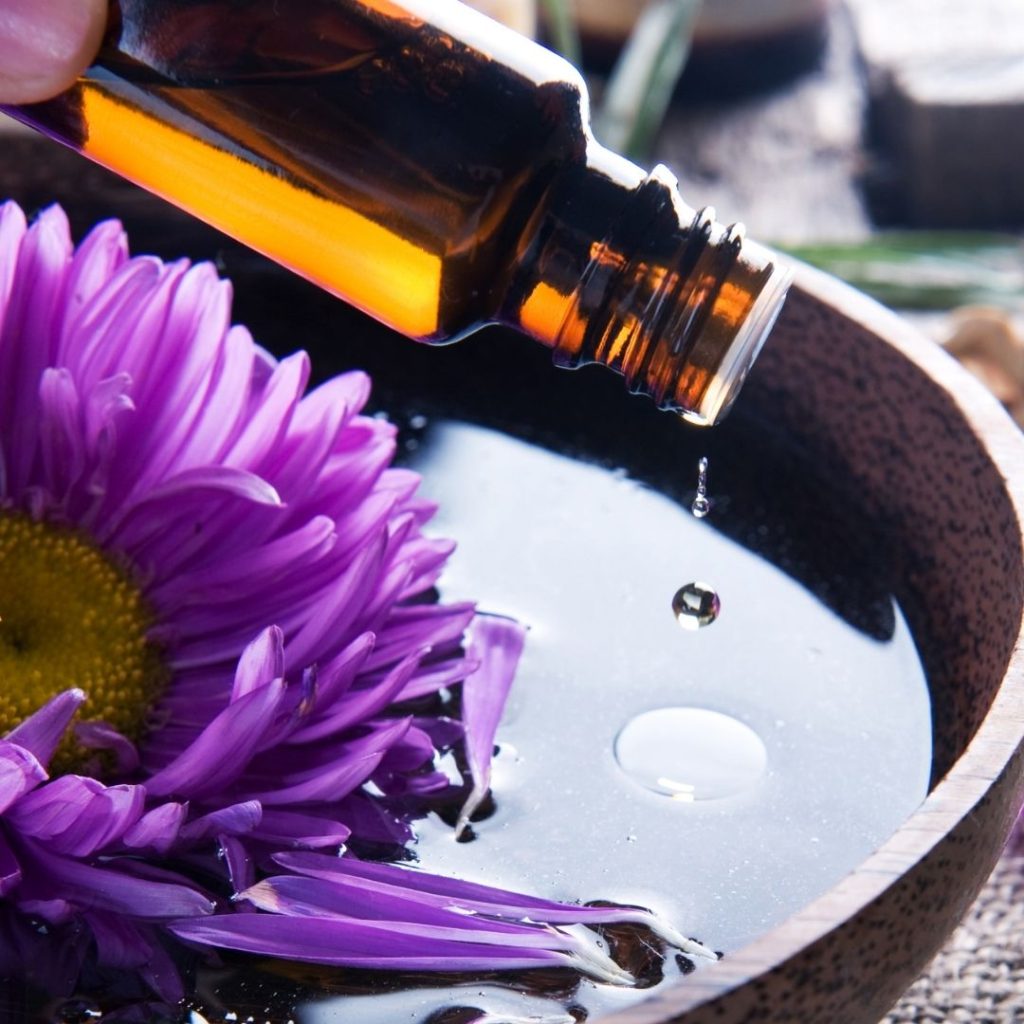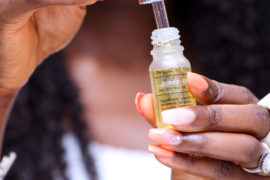It takes five dozen roses to produce a single drop of essential oil. If an essential oil is cheap, be wary.
Rose essential oil is extracted through steam distillation. The harvesting of flowers is traditionally done by hand in the morning before sunrise. Large stills, traditionally made of copper, are filled with the roses and water. The still is then fired for an hour or so. The vapourised water and rose oil leaves the still, enters a condensing apparatus, and is then collected in a flask. This yields a very concentrated oil. Water condenses with oil and is then drained off and distilled again. The two collections, once combined, make the final rose essence, or Rose Otto essential oil.
Rose Otto retails at around £48 for 2.5ml, and it is typically only used in aromatherapy, where it is diluted with a carrier oil. Like most essential oils, it should never be applied undiluted directly onto the skin. Aromatherapists love it as the distillation process is said to keep the therapeutic and vibrational qualities intact, but it does produce a less intense scent when compared to Rose Absolute, which is favoured in the perfume industry and is slightly more affordable at around £23 for half a teaspoon.
An Absolute, which again you may be familiar with as a Rose oil, is traditionally made using the enfleurage method. Enfleurage is a very old technique of extracting oils from very delicate flowers such as Rose, Tuberose or Jasmine, and was popularized in France during the nineteenth century. It works on the simple principle that animal fat, or beeswax, dissolves essential oils and thereby absorbs their aromas. The flowers, again hand-picked, are placed between layers of the fat or beeswax, repeatedly, over several days, until the fat becomes saturated with flower oil, producing a “pomade”. To extract the Absolute the fat or wax is then dissolved in alcohol, et voila!
The good news for those reluctant to use animal by-products is that organic solvent extraction is now a commonly used technique for extracting this form of aromatic. The raw materials are submerged and agitated in a solution or bath that is capable of dissolving the desired aromatic compounds. The price remains as high as we are still dealing with vast quantities of handpicked ingredients to yield the oil, but it is arguably kinder to the environment.
The price of Rose Absolute can come down even further when carbon dioxide extraction is used. In this method the CO2 is put under high pressure. This turns it into a liquid, and this combines with the plant matter and acts as a solvent extracting the oils or resin. It operates at lower temperatures with no toxins and is therefore the cleaner way of producing essential oil. When the CO2 is brought back to natural pressure it returns to its natural state leaving the resulting pure oil.
As you can see, any Rose oil should be respected as the process—whichever one it has been through—produces a very precious oil and one that should command a high price.
Roses are grown annually and can be repeatedly harvested, but there are less fruitful plants that are more difficult to harvest, and it is critical that they are protected to ensure sustainability of the species. One such plant is Frankincense.
The oil is derived from the resin of the super hardy Boswellia tree, which typically grows in the dry, mountainous regions of India, Africa and the Middle East, often in places that are difficult to get to. It takes 8 to 10 years before the tree, when tapped, yields the streaks of resin, known as tears. Wild harvested by making perforations into the bark of the trunk, the tears are collected and then steam distilled to produce the essential oil.
Experts say that the tree should be cut no more than 12 times a year to keep them healthy. When cut, resin leaks out and, much like a scab, protects the tree from infection so the wound can heal. But if this happens too much, and the healing resin is removed, the tree will ultimately suffer and die. In the mountain regions of countries like Somalia this is difficult to monitor as the trees grow in areas with harsh climates, often plagued by poverty and conflict, and may be the only source of income for local people.
Frankincense trees aren’t covered under the Convention on International Trade in Endangered Species (CITES), the global treaty that regulates cross border trade in plants and animals, although experts argue that Boswellia species meet the criteria for protection.
In Somaliland it is illegal to overharvest trees, and in Oman some trees are located in World Heritage sites that protect them by law, but in other countries such as Ethiopia, Eritrea and Sudan, where two thirds of Frankincense come from, the tree is threatened by over tapping and habitat loss.
In the case of Rosewood, CITES has put restrictions on the trade of all 300 species, in an attempt to clamp down on illegal logging of this timber. Having plundered the forests of Southeast Asia to virtual extinction traffickers have turned to West Africa and Central America for the prized timber. The good news is that reputable suppliers of this essential oil will always sell it with a CITES certificate so you can trace the origin of the Rosewood oil you are using and be sure it is grown and harvested sustainably.
The situation is similar for Sandalwood, a vulnerable species, but one that is prized in perfumery for its heartwood and roots. As a result of uncontrolled harvesting in India, where it is highly valued for its use in perfumes, soaps, incense, cosmetics and medicines, it is increasingly being grown under governmental protection. India has imposed an export ban on Sandalwood and instigated conservation measures to protect this species in their country. Sandalwood is now mainly grown sustainably in plantations in Australia, so again you need to be sure where your Sandalwood oil is being sourced if you really care about sustainability.
Happily, the horror stories of man abusing nature are counterbalanced by the occasional success story, where plants have been grown sustainably and in a controlled fashion, and man has applied his ingenuity for good. Vetiver is one such success story.
You may have heard of Vetiver in the context of perfumery. It has a wonderful woody, earthy base note, predominantly used in men’s fragrances. Vetiver is a tall grass. It can grow up to five feet, but more importantly the root structure can grow to a depth of 20 feet, which makes it fantastic at preventing soil erosion and promoting soil conservation. It is grown all over the world for a multiplicity of uses from basket weaving to Ayurvedic medicine, and as it can be planted and harvested in a two-year cycle, is a very sustainable product and one that provides tremendous support to agriculture practices and earnings around the world.
In Haiti, Vetiver is grown as a cash crop for the essential oils found in the roots, produced through steam distillation after much washing and drying to remove impurities and enhance the natural oil production.
Another of my great favourites, a plant grown sustainably, with multiple uses, which provides agricultural earnings in parts of the world where this is much needed, is Vanilla.
Vanilla has a particular place in history as it was the plant that kicked off man’s understanding of propagation. In the old days, wars were fought to own the land where prized spices could grow. After many years of fighting, the English finally traded the Banda Islands, the sole source of their prized Nutmeg, to the Dutch who gave them a small island called Manhattan in exchange. That was before Edmond Albius, a slave and horticulturist from Reunion, at the age of twelve, invented a technique for pollinating Vanilla orchids quickly and profitably. Albius’ technique revolutionised the cultivation of Vanilla and made it possible to grow Vanilla beans away from their native Mexico. Today nearly all Vanilla is pollinated using Albius’ technique and it has generated a world leading crop for Madagascar.
Despite this sustainable agricultural practice, Vanilla essential oil is still expensive as it is produced by Maceration. This is a very lengthy process as the raw material is first dried, soaked in a solvent for up to three years, and then dried for a further two years to allow the material to ferment. It is then cleaned with a solvent to isolate the pure essence.
This is the antithesis of the simplest of extraction methods, Expression, known to you and me as squeezing, is largely used for citrus essential oils such as Mandarin, Grapefruit, Lemon, Lime. These oils tend to be cheaper and, as they typically dissipate quickly, are generally used as top notes. As we all know, these fruits grow sustainably and plentifully close to home.
So, remember that the best essential oils are grown sustainably, imported by wholesalers who regularly inspect not only the growing methods but also the work practices of the farmers or growers and have a historical and regular relationship with the growers. Don’t be tempted by “bargain” prices.
ABOUT THE GUEST AUTHOR
Kim Brookes is the founder of Perfino, an innovative natural scent jewellery brand. Perfino combines expertly blended, 100% natural, pure essential oils with exquisite jewellery so you can wear scent all day long without any chemicals touching your skin. The solid recycled silver and 18ct gold vermeil, artisan designed pendant comes with six lava stones and 10ml of carefully blended natural essential oils – all sourced from sustainable growers. One drop of oil on the stone in the pendant will give you a delicate fragrance that can last for days.






5 Comments
Wow. Thanks for sharing. This is an in depth study.
Wow…it takes 5 dozen roses to make a drop! I had to read that three times!!! This article helped to explain the difference between prices and I’m now definitely willing to pay more. Such a detailed article!
Thank you Doris for reading and commenting. I know, most times we want to buy the cheaper ones but it doesn’t take that much to make it. Glad you find the post insightful x
Hi Carina Darling, This is vey insightful.
Thank you !